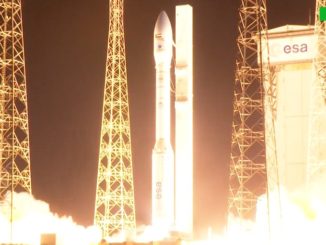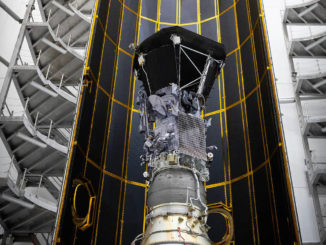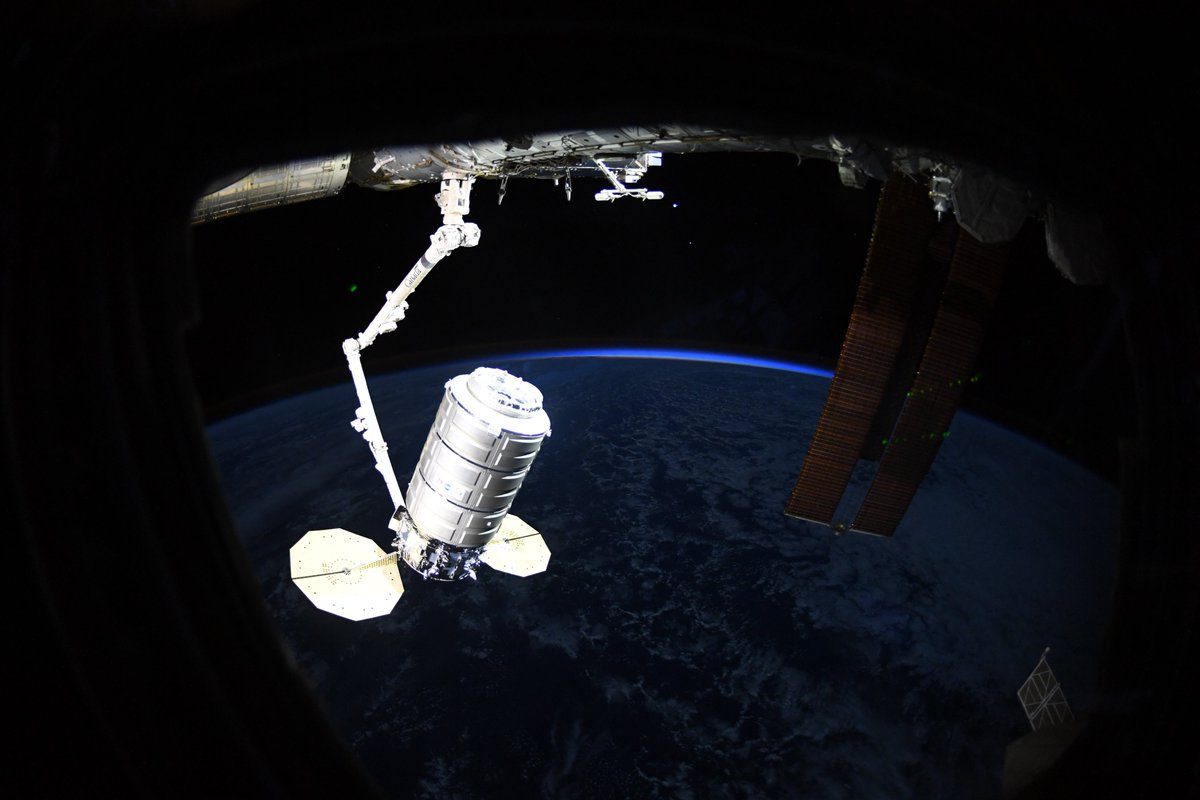
NASA flight engineer Anne McClain grappled Northrop Grumman’s Cygnus supply ship with the International Space Station’s robotic arm Friday, marking the automated cargo freighter’s arrival after an abbreviated day-and-a-half-long journey from a launch pad in Virginia with nearly 7,600 pounds of experiments, food and provisions.
Commanding the Canadian-built robot arm from a control station in the cupola module, McClain guided the arm’s end effector over a grapple pin on the rear end of the Cygnus spaceship as the cargo craft held steady roughly 30 feet (10 meters) below the complex. Mission control in Houston declared a successful capture of Cygnus at 5:28 a.m. EDT (0928 GMT) as the station sailed 258 miles (415 kilometers) over northeastern France.
Northrop Grumman christened the Cygnus the S.S. Roger Chaffee, after the late astronaut who perished in the Apollo 1 fire in 1967 alongside Gus Grissom and Ed White.
“It’s to have the S.S. Roger Chaffee officially on-board, and we look forward to working with the over 7,000 pounds of cargo for the next few months,” McClain radioed moments after the capture of Cygnus.
Engineers on the ground later took over the arm, which launched aboard the space shuttle Endeavour 18 years ago Friday, to place Cygnus on a berthing port on the nadir, or Earth-facing side of the station’s Unity module, where a series of latches and bolts closed to create a firm connection at 7:31 a.m. EDT (1131 GMT).
Friday’s arrival marked the end of a shorter-than-usual rendezvous profile for the Cygnus spacecraft following its launch from Wallops Island, Virginia, on Wednesday aboard an Antares rocket. Northrop Grumman modified the Cygnus flight plan to include a pair of automated altitude boost burns shortly after separation from the Antares launcher, giving the supply ship a head start on the way to the space station.
The change is one of several new upgrades and features on this Cygnus mission, the 11th and last resupply flight by Northrop Grumman under the company’s $2.89 billion cargo transportation contract with NASA signed in 2008. Northrop Grumman has a follow-on contract with NASA for at least six additional Cygnus missions beginning in October.
Under the second contract, Northrop Grumman will provide expanded cargo capacity to NASA, including the ability to load time-sensitive equipment into the ship’s pressurized module less than 24 hours before launch, and the revamped rendezvous profile to get to the station faster. Officials rehearsed the new procedures on this mission, designated NG-11.
On the next Cygnus mission, the Antares rocket’s main engines will fly at higher throttle settings, allowing the mission to carry up to 10 percent more cargo.
The station astronauts planned to open hatches leading to the Cygnus spacecraft’s internal cabin later Friday to begin unpacking the equipment inside, which includes a carrier containing 40 mice for researchers to study their immune systems in space by examining their bodies’ response to tetanus vaccinations. The rodents and their habitat were loaded into the Cygnus supply ship the night before launch, the first time mice have rode a Cygnus mission to the space station.
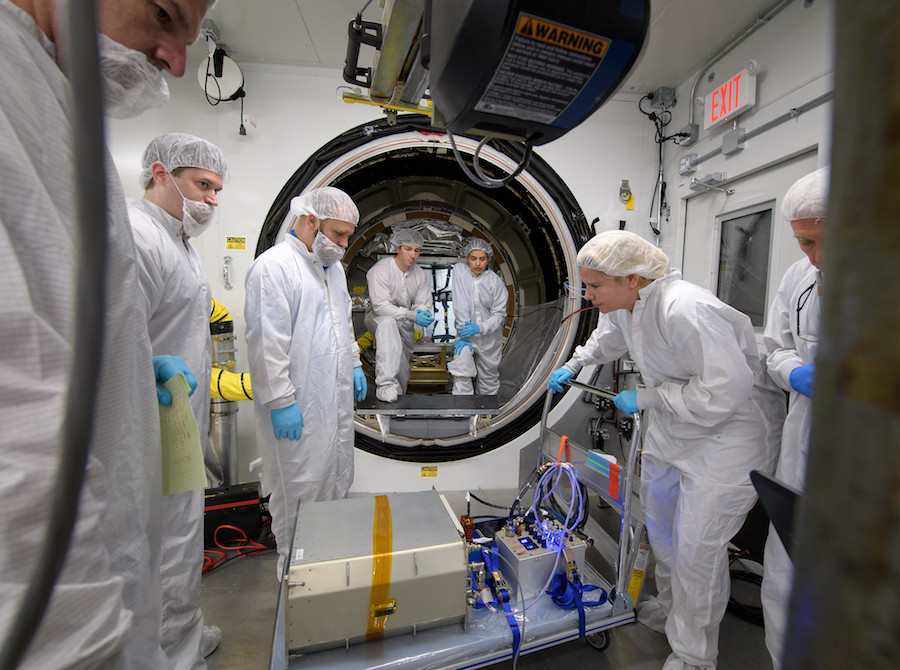
Two remotely-operated Astrobee robots developed at NASA’s Ames Research Center in California were also delivered to the space station Friday. The battery-powered cube-shaped robots will maneuver through the space station’s internal volume to perform inspections and assist crew members in their work, replacing NASA’s three aging SPHERES robots that have been on the station since 2006.
“We’re replacing them with the Astrobee, so we’ve built in a lot of features in the Astrobee to actually facilitate research,” said Maria Bualat, Astrobee’s project manager and deputy lead of the intelligent robotics group at Ames. “One is that there are multiple payload bay … So we have these open areas on the robot where you can plug in, both at the top and bottom, payloads very easily.”
In the last few years, the SPHERES robots have conducted experiments investigating sloshing of liquids inside space vehicles and the robotic capture of space debris. Like SPHERES, the Astrobee robots will allow researchers to demonstrate new capabilities in a controlled pressurized environment inside the space station.
“It can be used for science and technology development,” Bualat said. “So it can carry other payloads that we want to test in microgravity but it can also be used as a tool by ground controllers. So we can use the camera to do video surveys or to observe crew activities, so that the ground can be actually ready to answer any questions the crew might have in a complex activity, and they also don’t have to take crew time to move the camera. So if the camera happens to be placed badly … they can actually just fly the camera to another location.
“The other thing we can do is we can carry other instruments,” she said. “We can carry sensors for environmental understanding, so for instance CO2 sensors to understand the concentrations, we can carry radiation sensors, we also can carry RFID readers that can do inventories and find lost tools or lost equipment that we’re not sure where it is. We can actually fly the robot around and look for equipment needed for other experiments. In that way, we don’t have to have the crew looking for a needed piece of equipment.”
The Astrobee robot will use vision-based navigation — comparing what it sees to a pre-loaded map of the station — to know where it is on the space station, according to Bualat. A propulsion module using air intakes and nozzles will provide the impulse needed to fly around the space station, and a docking port is available to connect to each robot for battery charging.
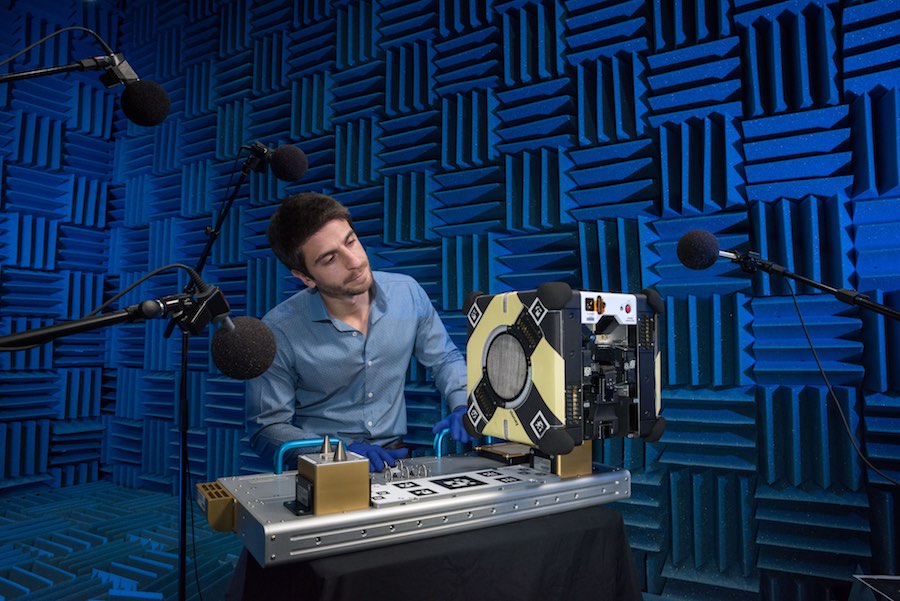
“It pulls air in through a circular central fan, which lightly pressurizes the propulsion module, and then there are six nozzles on each side — so 12 total — that open and close, and that is how the robot moves around station,” Bualat said.
A third Astrobee robot is expected fly on a SpaceX cargo mission to the station later this year.
Other hardware carried by the Cygnus spacecraft includes a device designed to manufacture optical fibers in orbit. The Space Fibers facility, developed by a San Diego company named FOMS, will help engineers determine the effectiveness and quality of optical fibers manufactured in microgravity.
FOMS is one of two companies, along with Made in Space, seeking to manufacture optical fibers on the space station. Officials from both companies believe a blend of materials called ZBLAN — which stands for zirconium, barium, lanthanum, sodium and aluminum — can be assembled into optical fibers in microgravity with higher quality than traditional silica-based fibers used on Earth.
“The immediate opportunities for these fibers are in remote sensing and defense applications, but there is a wide market opportunity for telecom applications as well,” said Dmitry Starodubov, chief scientist for the Space Fibers facility from FOMS Inc.
Eleven CubeSats developed by students and startup companies also rode to the station inside the Cygnus cargo module. The astronauts will take the CubeSats to the station’s Japanese Kibo lab module, where they will be installed on a deployer for transfer through Kibo’s airlock and release into orbit from the robot arm.
The CubeSats launched inside Cygnus for deployment from the space station include:
- EntrySat was developed by the ISAE-SUPAERO aeronautics and space institute in France with support from CNES, the French space agency. The 3U CubeSat, about the size of a loaf of bread, was built by French students and will use position, pressure, temperature and heat flux sensors to study re-entry of orbital debris, according to CNES.
- IOD-1 GEMS is the first in-orbit demonstration 3U CubeSat for a Global Environmental Monitoring System constellation planned by Orbital Micro Systems, a Colorado-based company with a major data center in Scotland. The IOD-1 GEMS nanosatellite is funded by Innovate UK, and will gather and transmit atmospheric observation data. It is the first of Orbital Micro Systems’ planned fleet of 48 CubeSats to collect global microwave radiation data for weather forecasting.
- KRAKSat, developed by students at the University of Science and Technology and Jagiellonian University in Poland, will test the viability of a ferrofluid flywheel to control the nanosatellite’s orientation in space. “A torus, surrounded by eight electromagnets, and placed inside a ferrofluid is a main part of our experiment,” the KRAKSat team wrote in a mission summary. “By changing magnetic field, we accelerate the ferrofluid, causing its spinning motion. The result of this movement should be the rotation of the satellite in the opposite direction.”
- Swiatowid is a technology demonstration satellite developed by SatRevolution S.A., a Polish startup company. The 2U CubeSat carries a telescope and an “industry-quality” camera sensor to demonstrate high-resolution imaging from low Earth orbit using small satellites. Swiatowid is designed to collect imagery with a ground sample distance of 3 meters, or about 10 feet, and the team aims to improve that to 1 meter (3 feet) on future missions.
- The Virginia CubeSat Constellation mission consists of three 1U CubeSats, each a bit larger than a Rubik’s cube, developed by Virginia undergraduate students at the University of Virginia, Old Dominion University, Virginia Tech and Hampton University. Named Aeternitas, Cetes and Libertas, the CubeSats will measure the orbital decay of a constellation of small satellites and develops a database of atmospheric drag and the variability of atmospheric properties, according to NASA.
- Uguisu, Raavana 1, and NepaliSat 1 are 1U CubeSats developed by student and research teams in Japan, Sri Lanka and Nepal under the auspices of the international Birds program.
- SpooQy 1, developed at the National University of Singapore, will demonstrate quantum entanglement with a CubeSat for the first time.
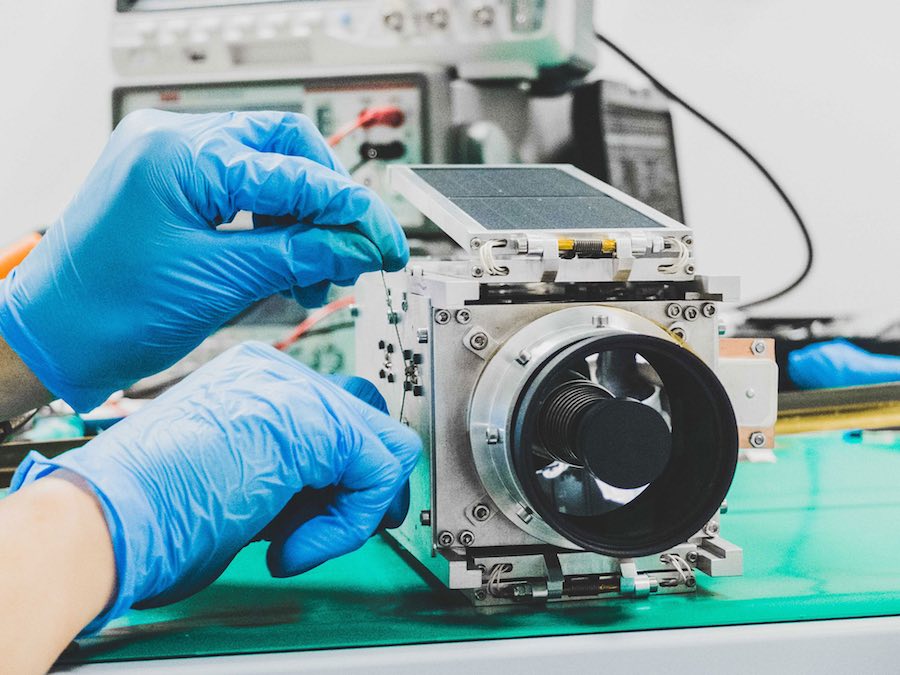
The Cygnus spacecraft also delivered the equivalent of more than 800 meals to the space station, according to NASA. The meals include smoked turkey, pork chops, shrimp cocktail, and desserts such as cherry cobbler, chocolate pudding and lemon cake.
The S.S. Roger Chaffee’s pressurized cargo module, built by Thales Alenia Space in Italy, is packed with 6,971 pounds (3,162 kilograms) of supplies and experiments. Here’s a breakdown of the cargo manifest provided by NASA:
- 3,459 pounds (1,569 kilograms) of science investigations
- 2,065 pounds (936 kilograms) of crew supplies
- 1,384 pounds (628 kilograms) of vehicle hardware
- 77 pounds (35 kilograms) of Northrop Grumman hardware
- 53 pounds (24 kilograms) of spacewalk equipment
- 10 pounds (5 kilograms) of computer resources
More than 500 pounds of additional payload hardware is affixed outside the Cygnus spacecraft to support CubeSat deployments after departing the space station, bringing the total payload complement on NG-11 to 7,575 pounds (3,436 kilograms).
The Cygnus supply ship is expected to remain berthed at the International Space Station’s Unity module until July 23, when it will be released by the station’s robotic arm with several tons of trash for disposal.
Northrop Grumman’s ground team in Dulles, Virginia, will send the Cygnus spacecraft into a higher orbit for deployment of several more CubeSats from a NanoRacks module and a Slingshot mechanism.
One of the CubeSats to be released after Cygnus’ departure from the space station is named Seeker. Developed at NASA’s Johnson Space Center in Houston, with a camera system provided by engineers at the University of Texas at Austin, Seeker will perform an inspection of the Cygnus spacecraft to demonstrate in-space navigation and imaging capabilities that could be used on future missions in deep space.
Two AeroCube 10 nanosatellites from the Aerospace Corp. will also separate from Cygnus to conduct experiments in satellite-to-satellite pointing, evaluate the use of a water-based stream thruster, and release 29 tiny atmospheric probes to measure air density in low Earth orbit.
Northrop Grumman plans several months of long-duration spaceflight experiments using the Cygnus spacecraft after release of the CubeSats. Four miniaturized control moment gyroscopes are flying on the cargo freighter for the first time, and engineers will assess their performance in controlling the spacecraft’s pointing without consuming rocket fuel.
Ground teams also want to evaluate how the Cygnus spacecraft’s avionics function on a long-duration mission, and Northrop Grumman plans to demonstrate dual Cygnus operations for the first time after the launch of the company’s next resupply mission later this year.
Like all previous Cygnus missions, the spacecraft will burn up during re-entry over the Pacific Ocean once the extended mission demonstration is complete.
Email the author.
Follow Stephen Clark on Twitter: @StephenClark1.

